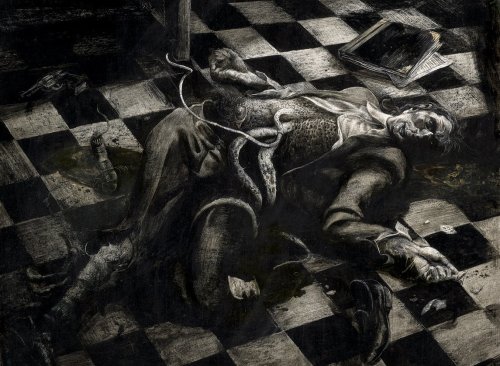The Dunwich Horror
 Monday, January 16, 2012 at 16:07
Monday, January 16, 2012 at 16:07 What is the Dunwich Horror? It surfaces late in the eponymous tale, and whether it meets the reader's expectations cannot be determined until one determines the reader. There are many people who worship Lovecraft for his style; indefinitely more who just like him because, well, he writes about gooey stuff; still others who may be seeking what his characters invariably seek, which cannot under any circumstances be recommended. Indeed, Lovecraft's style sets him distantly apart from other purveyors of the fantastic, with the possible exception of James, although James's cobwebbed ghouls could not be any more distinct from Lovecraft's extragalactic behemoths. Which brings us to a wretched little town in Northern Massachusetts by the name of Dunwich.
 Dunwich, now and then (to wit, at the time of "the Horror," the Fall of 1928), cannot pride itself on its hospitality. It is rather the type of place you approach in slow dread, sensing somehow that evil's winds caress more than chimes and porch lights. An early description confirms the narrator's fears:
Dunwich, now and then (to wit, at the time of "the Horror," the Fall of 1928), cannot pride itself on its hospitality. It is rather the type of place you approach in slow dread, sensing somehow that evil's winds caress more than chimes and porch lights. An early description confirms the narrator's fears:
Without knowing why, one hesitates to ask directions from the gnarled, solitary figures spied now and then on crumbling doorsteps or on the sloping, rock-strown meadows .... Outsiders visit Dunwich as seldom as possible, and since a certain season of horror, all the signboards pointing toward it have been taken down. The scenery, judged by any ordinary aesthetic canon, is more than commonly beautiful; yet there is no influx of artists or summer tourists. Two centuries ago, when talk of witch-blood, Satan-worship, and strange forest presences was not laughed at, it was the custom to give reasons for avoiding the locality.
The kinship with these trials is hardly coincidence, and Dunwich's actual proximity to Salem suggests that inexplicable phenomena were a daily occurrence in this troubled region. One of these phenomena will be the birth of Wilbur Whateley on Feb 2, 1913, a "date recalled because it was Candlemas, which people in Dunwich curiously observe under another name," and what name this may be needs no mention here. Young Wilbur – he will remain ever young despite the astounding growth he will evince – develops both height and speech of near-inhuman dimensions, as guided by his maternal grandfather (as it were, his paternal ancestry is more than hinted at from the very beginning of the tale: "he was ... extremely ugly ... there being something almost goatish or animalistic about his thick lips, large-pored yellowish skin, coarse crinkly hair, and oddly elongated ears"). As we learn more about Wilbur, about the nightly shrieks that rattle a clapboarded attic, about his vanished, hysterical mother, about the nature of the types of books he wishes to borrow from some of the world's finest libraries, we understand as much as can be understood from the situation. Namely, that a smart person should walk quickly away, and if to speculate, then very far away as well.
Alas, we cannot help but read on. At length an old professor called Henry Armitage, a scholar at this fictional university, rejects Wilbur's in-person request for a Latin copy of the Necronomicon, a wicked tome Hellenists can tell you bodes poorly for all of us. Wilbur, at this point, a "bent, goatish giant .... [and] probable matricide .... almost eight feet tall," retreats to his hellish estate with little argument. His next appearance, in the same library, will be somewhat more dramatic, as Armitage and two other university professors can attest:
It was partly human, beyond a doubt, with very man-like hands and head, and the goatish, chinless face had the stamp of the Whateleys upon it. But the torso and lower parts of the body were teratologically fabulous, so that only generous clothing could ever have enabled it to walk on earth unchallenged or uneradicated. Above the waist it was semi-anthropomorphic; though its chest ... had the leathery, reticulated hide of a crocodile or alligator. The back was piebald with yellow and black, and dimly suggested the squamous covering of certain snakes. Below the waist, though, it was the worst; for here all human resemblance left off and sheer phantasy began. The skin was thickly covered with coarse black fur, and from the abdomen a score of long greenish-grey tentacles with red sucking mouths protruded limply. Their arrangement was odd, and seemed to follow the symmetries of some cosmic geometry unknown to earth or the solar system. On each of the hips, deep set in a kind of pinkish, ciliated orbit, was what seemed to be a rudimentary eye; whilst in lieu of a tail there depended a kind of trunk or feeler with purple annular markings, and with many evidences of being an undeveloped mouth or throat. The limbs, save for their black fur, roughly resembled the hind legs of prehistoric earth’s giant saurians; and terminated in ridgy-veined pads that were neither hooves nor claws. When the thing breathed, its tail and tentacles rhythmically changed colour, as if from some circulatory cause normal to the non-human side of its ancestry .... Of genuine blood there was none; only the foetid greenish-yellow ichor which trickled along the painted floor beyond the radius of the stickiness, and left a curious discolouration behind it.
What is described in the above passage is very much Wilbur Whateley in the earthly form he bore for the duration of his life in Dunwich; it is his genetic admixture that we cannot ascertain. Armitage does not really want to know, either, but takes it upon himself to decipher an ancient text and,with the horrible knowledge therefrom obtained, avert a catastrophe.
The curious will already have used another intergalactic tool, Google, and acquired a notion if not a rendering of the beast, and so be it. The Dunwich Horror, while suffering through far too many paragraphs in what Lovecraft concocted as a northern Massachusetts dialect, represents his genius at its peak, even if the plot has much of the straight path of destiny. These types of stories engage the fancifulness of the curious, because it is only through re-imagination, through the reasoned categorization of images and meanings in the conscious and well-tuned brain that permits that same brain to become saturated with fear. Such is Lovecraft's gift: even when his characters could not possibly be of benevolent origin, real suspense nevertheless builds as to the degree of their evil. Some agenda-toting critics have alleged that for all his sublime sense of the eerie and the otherworldly, Lovecraft himself could not believe in anything greater than the coarse desert sands of the mirage-plagued materialist. While we may accept his own doubts (these same critics declaim all Lovecraft's quotes that even imply a hesitation in this regard) as to his faith in something akin to a monotheistic deity, to insist that Lovecraft believed in nothing greater than the ambition of his five senses would be blasphemy itself. No writer has ever portrayed the demonic undercurrent of horror with as much verve and composure. And no one could imbue his reader with as much apprehension of what "kind of force ... doesn't belong in our part of space," and instead exists "not in the spaces we know, but between them." And even if you turn to Lovecraft for the gooey stuff, I think you know exactly what I mean.

